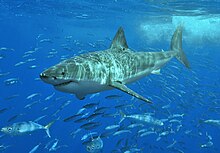
The Hexanchiformes are the order consisting of the most primitive types of sharks, and numbering just seven extant species. Fossil sharks that were apparently very similar to modern sevengill species are known from Jurassic specimens.

The Lamniformes are an order of sharks commonly known as mackerel sharks. It includes some of the most familiar species of sharks, such as the great white, as well as more unusual representatives, such as the goblin shark and megamouth shark.

Megalodon, meaning "big tooth", is an extinct species of mackerel shark that lived approximately 23 to 3.6 million years ago (Mya), from the Early Miocene to the Pliocene epochs. It was formerly thought to be a member of the family Lamnidae and a close relative of the great white shark. However, it is now classified into the extinct family Otodontidae, which diverged from the great white shark during the Early Cretaceous.
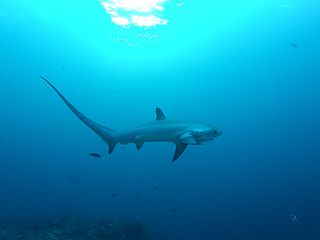
Thresher sharks are large lamniform sharks of the family Alopiidae found in all temperate and tropical oceans of the world; the family contains three extant species, all within the genus Alopias.
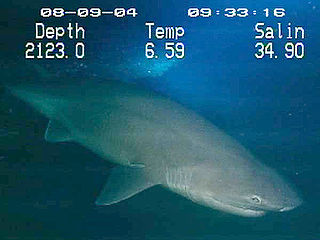
Cow sharks are a shark family, the Hexanchidae, characterized by an additional pair or pairs of gill slits. Its 37 species are placed within the 10 genera: Gladioserratus, Heptranchias, Hexanchus, Notidanodon, Notorynchus, Pachyhexanchus, Paraheptranchias, Pseudonotidanus, Welcommia, and Weltonia.

The shortfin mako shark, also known as the blue pointer or bonito shark, is a large mackerel shark. It is commonly referred to as the mako shark, as is the longfin mako shark. The shortfin mako can reach a size of 4 m (13 ft) in length. The species is classified as Endangered by the IUCN.

The porbeagle is a species of mackerel shark in the family Lamnidae, distributed widely in the cold and temperate marine waters of the North Atlantic and Southern Hemisphere. In the North Pacific, its ecological equivalent is the closely related salmon shark (L. ditropis). It typically reaches 2.5 m (8.2 ft) in length and a weight of 135 kg (298 lb); North Atlantic sharks grow larger than Southern Hemisphere sharks and differ in coloration and aspects of life history. Gray above and white below, the porbeagle has a very stout midsection that tapers towards the long, pointed snout and the narrow base of the tail. It has large pectoral and first dorsal fins, tiny pelvic, second dorsal, and anal fins, and a crescent-shaped caudal fin. The most distinctive features of this species are its three-cusped teeth, the white blotch at the aft base of its first dorsal fin, and the two pairs of lateral keels on its tail.

Sand sharks, also known as sand tiger sharks, grey nurse sharks or ragged tooth sharks, are mackerel sharks of the family Odontaspididae. They are found worldwide in temperate and tropical waters. The three species are in two genera.

Heptranchias is a genus of sharks in the family Hexanchidae.

Myliobatis is a genus of eagle rays in the family Myliobatidae.

Lamna is a genus of mackerel sharks in the family Lamnidae, containing two extant species: the porbeagle of the North Atlantic and Southern Hemisphere, and the salmon shark of the North Pacific.
Edaphodon was a fish genus of the family Callorhinchidae. As a member of the Chimaeriformes, Edaphodon was a type of rabbitfish, a cartilaginous fish related to sharks and rays. The genus appeared in the Aptian age of the Lower Cretaceous and vanished in the Pliocene. It was most prominent during the Late Cretaceous. Many Edaphodon species were found in the Northern Hemisphere, but species from the Southern Hemisphere are also known.
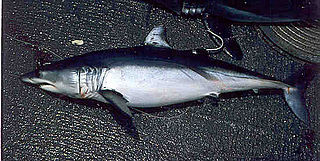
Isurus is a genus of mackerel sharks in the family Lamnidae, commonly known as the mako sharks.

Carcharias is a genus of sand tiger sharks belonging to the family Odontaspididae. Once bearing many prehistoric species, all have gone extinct with the exception of the critically endangered sand tiger shark.

Otodus angustidens is a species of prehistoric megatoothed sharks in the genus Otodus, which lived during the Oligocene and Miocene epochs about 33 to 22 million years ago. This shark is related to another extinct megatoothed shark, Otodus megalodon.

Otodus chubutensis, meaning "ear-shaped tooth of Chubut", from Ancient Greek ὠτ and ὀδούς – thus, "ear-shaped tooth", is an extinct species of prehistoric megatoothed sharks in the genus Otodus, that lived during Oligocene, Miocene, and Pliocene epochs, approximately 28 – 5 million years ago. This shark is considered to be a close relative of the famous prehistoric megatoothed shark, O. megalodon. However, as is the case with O. megalodon, the classification of this species is disputed.
Eostriatolamia is an extinct genus of sharks in the family Odontaspididae. It was described by Gluckman in 1980. A new species, E. paucicorrugata, was described from the Cenomanian of Canada by Charlie J. Underwood and Stephen L. Cumbaa in 2010.

Cosmopolitodus planus, also known as the hooked-tooth mako shark or hooked mako shark, is an extinct lamnid that lived during the Miocene epoch from 23 to 5 million years ago. C. planus can be found only in marine deposits on the Pacific Rim, especially the west coast of the United States. Teeth belonging to C. planus can reach lengths of 2.0 in (5.0 cm), and are often found in the Temblor Formation of Bakersfield, California.

Cosmopolitodus is an extinct genus of mackerel shark that lived between thirty to one million years ago during the late Oligocene to the Early Pleistocene epochs. Its type species is Cosmopolitodus hastalis, the broad-tooth mako. In 2021, Isurus planus was reassigned to the genus, and thus became the second species C. planus. Its teeth can reach lengths up to 3.5 in (7.5 cm) and are found worldwide. It is believed to be an ancestor to the great white shark, an argument supported by the transitional species Carcharodon hubbelli, but as of 2021, no phylogenetic analyses have been done for proof.
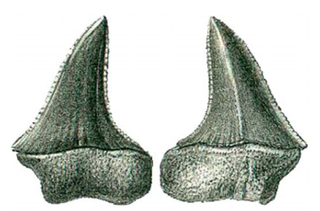
Carcharomodus escheri, commonly nicknamed the serrated mako shark or Escher's mako shark, is an extinct lamnid that lived during the Miocene. It has been formerly thought to have been the transitional between the broad-toothed "mako" Cosmopolitodus hastalis and the modern great white, but is now considered to be an evolutionary dead-end with the discovery of Carcharodon hubbelli. Fossil examples have been found along northern Atlantic coastlines and in parts of Western and Central Europe.
